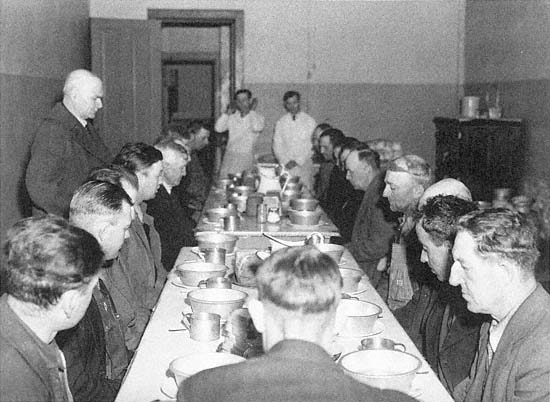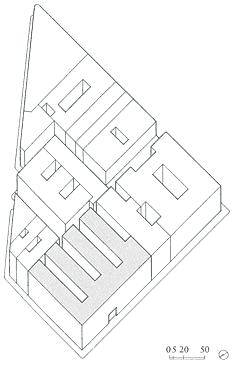Racial Rooming House Districts:
The Chinatown Example
The racial ghettos of many cities have had a high number of inexpensive hotel homes. San Francisco's Chinatown was somewhat unique, since the Chinese were imported as inexpensive laborers early in the city's history and were allowed, even after the fire, to remain in their downtown location—a three-block by seven-block Chinatown crammed with

Figure 5.18
Compulsory prayer before dinner at a charitable mission, Dubuque, Iowa, 1940.
boardinghouses and lodging houses. In some ways, Chinatown was much like the Anglo South of Market. Chinatown had many privately owned cheap lodging houses and some better rooming houses; in 1980, half of the area's housing units were still in SROs. Chinatown's streets and basements were filled with affordable retail services and employment offices. There were counterparts to the missions, although Christian missions in Chinatown more vigorously took on acculturation as well as salvation. The population was largely male—but for a different reason. Until the 1960s, federal law forbade importation of wives and created a bachelor society in Chinatown. Wage conditions for the Chinese were even worse than those faced by American-born casual workers. Because of ghetto confinement, the Chinese neighborhood could not expand in spite of population pressures. Hence, the hotel housing conditions were worse. Whites, especially city officials and the police, saw Chinatown as a convenient place to dump (or not see) unsavory characters and illicit activities, even though this meant that gambling
houses, brothels, and drug dens were mixed with a law-abiding population of workers. As in other racial ghettos, a few local residents profited from the dumping process.[60]
Chinatown hotel buildings built after the 1906 earthquake, on their exterior, looked just like their counterparts in the South of Market or waterfront areas. The rooms and windows were similar sizes, often matching code minimums. Inside, however, the forces of economics, management, and ownership forced densities four times those assumed in the building standards. The Chinatown lodging house rooms were crowded with bunk beds. Men commonly slept in shifts, and tenants often did their own cooking in simple communal kitchens. To help each other ignore this appalling population density, Anglos used cultural stereotypes such as "the Chinese tolerate crowding better than white people." Whites (not aware that Chinese were rarely allowed to own property) also defended the densities by pointing to Chinese-managed family association buildings, which had similar densities on their living floors. The multiuse family association buildings functioned in part as subsidized lodging houses. On the ground floor would be commercial spaces leased to leading association members; on the second and third floors were crowded hotel rooms that housed bachelor members; on the top floor were offices, meeting rooms, or social halls for the entire association.[61]
San Francisco's Chinatown was neither monolithic nor completely Chinese. Almost immediately it became an important tourist zone and (on a square-footage basis) probably did far more profitable retail business than did the Howard Street businesses. White workers and non-Chinese Asians also lived in significant numbers on the edges of Chinatown. In the late 1800s, Mexican workers lived directly to the east. After 1900, Manilatown—a concentration of thirty-seven hotels housing up to 10,000 Filipino workers—straddled the border between the core of Chinatown and the Barbary Coast. The workers used the Lucky M Pool Hall as their informal information center. San Francisco's International Hotel, of 1977 eviction fame, was a workers' hotel of a fairly typical 184-room size built in 1907 (fig. 5.19). Twelve stores filled the ground floor, and billiard halls and a well-known nightclub were housed in its basement.[62] A block to the west, in 1939, the permanent residents of the border-location Clayton Hotel revealed the

Figure 5.19
Axonometric view of the International Hotel
and surrounding buildings in Manilatown,
San Francisco. The 184-room hotel (shaded)
was built in 1907 with more generous light
wells and larger rooms than average.
In this block, most structures are hotels.
area's ethnic and racial mixture: 25 Filipino, 15 Chinese, and 22 white workers.
While most Chinese were segregated into Chinatowns, city authorities on the West Coast allowed Japanese immigrants to operate and live in rooming and lodging houses in several districts of the city, usually outside of Chinatown. Some white workers preferred Japanese-leased hotels because of their management style. In San Francisco's Western Addition, Japanese-managed hotels seem to have been racially mixed; in the South of Market, all-Japanese residents were more the rule.[63]
Until the 1930s, San Francisco had a very small black population. However, in other cities lodging house districts for blacks were similar to San Francisco's Chinatown. Like Chinatowns, black lodging house districts crowded workers (who were paid less than their white counterparts), suffered from double housing standards in city inspection and code enforcement, and endured a high proportion of unsavory uses dumped there by outsiders. The several-block area of cheap lodging houses in the middle of Chicago's Black Belt was a prime example. It served thousands of black workers who were hired by the railroads and meat packers, where blacks could get jobs earlier than they could in
most other industries (fig. 5.20). In 1990, it remained as one of the largest remaining SRO concentrations on the city's South Side.[64]
Another lodging house pattern, front-gate lodgings, served workers stranded at an eccentric industrial location. For large factories initially built beyond the edge of the city, speculators often built nearby clusters of rooming and lodging houses as well as family houses and flats. San Francisco's Union Iron Works, for instance, employed up to 5,000 men but was four miles from Third and Howard. The hour walk each way to and from the factory cut too much into the casual laborer's day. By 1900—with the factory owners actively encouraging the development—the workers could choose from over thirty commercial wooden rooming and lodging houses and almost as many saloons within three blocks of the factory gate (fig. 5.21).[65]